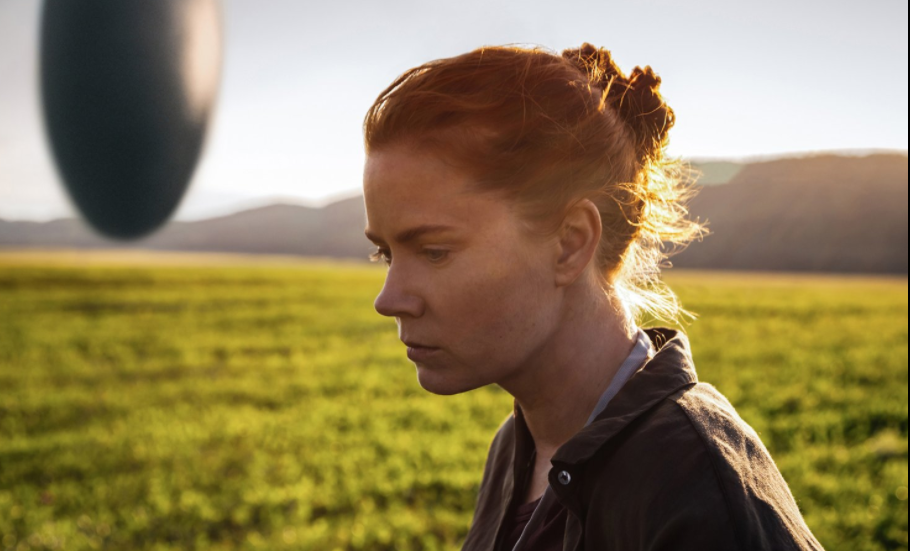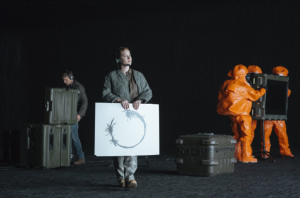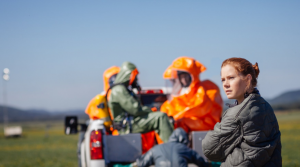Louise Banks (Amy Adams) stands on a forklift ascending into an alien space ship, one of twelve that have landed all over the world. Her face is covered by a plastic helmet, and her body is encased in a fluorescent orange hazmat suit to prepare to enter an alternate, potentially dangerous universe. Her eyes stare up the tunnel, wide with apprehension for what lies ahead. The sound of her shallow breaths dominates the sound of the scene. This is a human reacting to something beyond the scope of human conception: the arrival of aliens.
Arrival, directed by Denis Villeneuve, tells the story of the day the aliens arrived, landing 12 ships in places around the world including the United States, Peru, Britain, and Japan. The movie is based off “Story of Your Life,” a short story written by Ted Chiang, and was artfully adapted into a screenplay by Eric Heisserer. Louise Banks, a linguist, is brought in by the U.S. Army to determine how to communicate with the visiting heptapods, named for their seven legs, and to figure out their purpose for coming to Earth. Ian Donnelly (Jeremy Renner) is a theoretical physicist leading the scientific side of the inquiry. As Louise begins to decipher the heptapods’ language, she must race to help the military determine if the aliens have violent intentions and how to work together with the other 11 nations where the ships have landed.
This movie about the arrival of the aliens is at its heart about the encounter with “the other.” Villeneuve and Patrice Vermette, the production designer, did an excellent job representing an other-worldly species and their language while making them approachable. The heptapods look vaguely like octopuses and even spray ink to communicate. Everything about them is foreign, yet their octopus-like appearance makes them feel a little more familiar. The heptapods’ language is made up of floating circular logograms, and again Villeneuve and Vermette combined the familiar and the foreign by making the symbols reminiscent of circular Rorschach inkblot tests. The heptapods’ ship is an intriguing shock. Shaped like a strange egg, it floats 30 feet off the ground, leaving it up to the human race to make contact. An important element is the location of the ships which are not in famous locations like the White House or the Eiffel Tower, instead landing in the middle of a Montana field and a neighborhood in Peru. This choice and the overall design of the movie reinforces the idea of “the other” invading everyday life.
On the same note, one of the best elements of the film was the disconcerting sense of normalcy throughout. This shone through in the plot as well as in the cinematographic choices. It was a conscious choice of Villeneuve along with cinematographer Bradford Young to make the entire film look like it took place on an unremarkable Tuesday morning . In the words of the director, they hoped to achieve a “dirty sci-fi” kind of look. Bradford departed from the conventional futuristic lighting choices of most sci-fi films and instead chose to rely on rainy, overcast skies and fluorescent lights inside the military tents. Though the plot heavily relied on the arrival of the heptapods, Louise’s life played an equally large role. Young took this into account and brought a distinctly human element to scenes of this genre. Scenes depicting moments between Louise and her daughter employed fuzzy edges, intense focus on the characters’ faces, and soft lighting like that of the sun peeking out of a cloudy sky. All these effects were meant to evoke the feeling of a memory replaying in your head, and captivated the attention of the audience.
Music also drew the audience into the action and emotion of Arrival. Composer Jóhann Jóhannsson worked with Theatre of Voices, a Danish vocal ensemble, to achieve an other-worldly sound by combining the sounds of vowels without any inherent meaning being sung. It puts the listener off guard, paralleling the feelings of the characters on screen. Each song had a purpose, infusing a feeling into a scene. In one montage sequence, Louise and Ian are trying various tactics to decipher the heptapods’ language. A song, “Heptapod B” plays in the background and follows the action on screen, starting calmly with a woman’s voice singing the phonetic unit, “na,” and gaining in intensity as Louise and Ian begin to make progress with the language. The song develops just as Louise’s understanding of the language does.
It’s a welcome surprise that the hero of Arrival is communication rather than big guns and large explosions (though there are plenty of those too). And furthermore that a woman, amongst scores of men at a military encampment, is the one to save the day. Louise realizes how to solve the crisis when she discovers the heptapods’ logograms don’t conform with a linear narrative of time. The ending is too mind-bending to give more away than that, and only watching the movie will do it justice. Villeneuve’s Arrival isn’t just a run-of-the-mill sci-fi movie. It connects directly to our modern-day world, leaving the viewer questioning their relationship with “the other” and the trajectory of their life.





